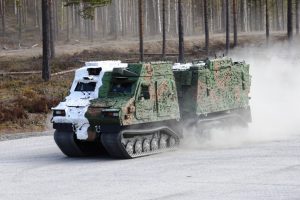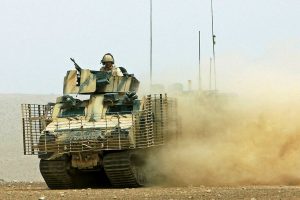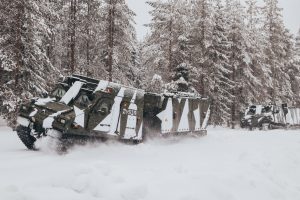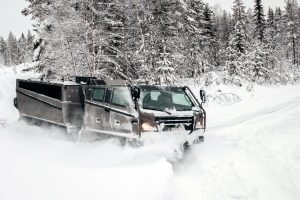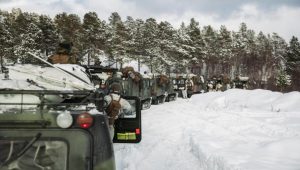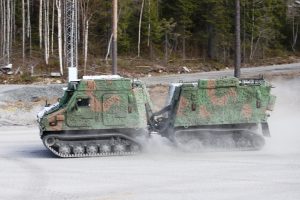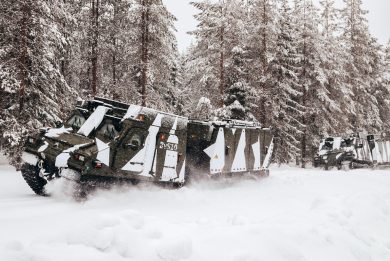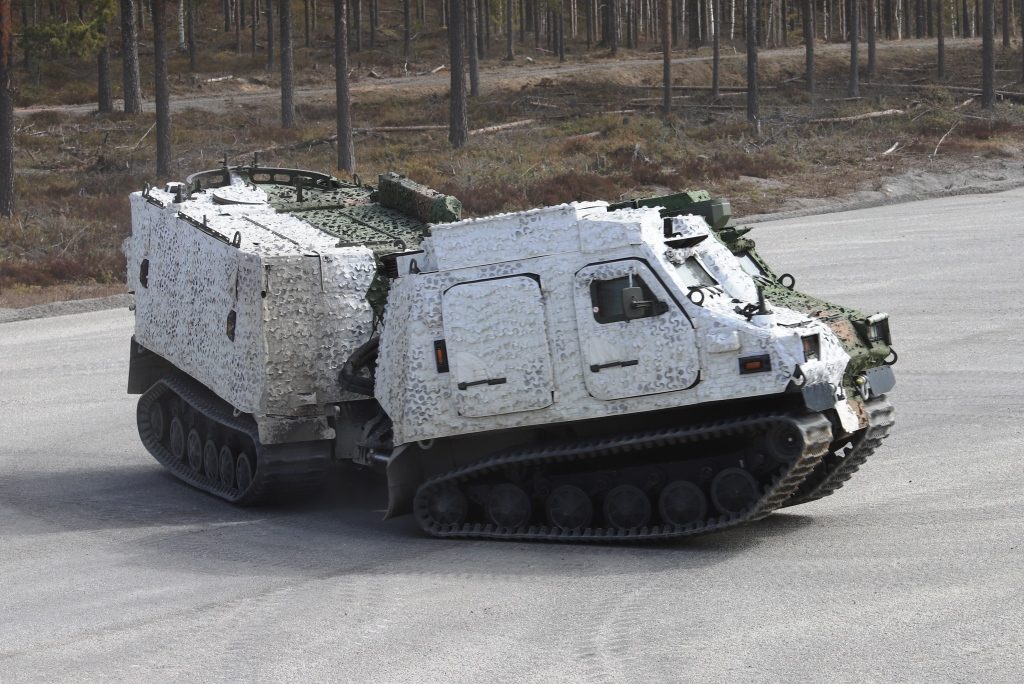
BAE Systems Hägglunds segmented vehicles, today and tomorrow
EDR On-Line was recently invited visiting BAE Systems Hägglunds facilities in Örnsköldsvik, around 450 km north of Stockholm. In that occasion it was possible to test drive the company demonstration BvS10, the latest development of tracked segmented vehicles designed for snowy and difficult terrain.
These trace back to the first BVs (Bandvagen, that is tracked vehicle), designed in the 1960s by Bolinder-Munktell, a subsidiary of Volvo, to answer Swedish Army requirements, followed in the 1970s by the Bv206, designed and produced by then Hägglunds, now part of BAE Systems. Although heavier than similar vehicles tested before, the BvS10 proved to be of easy handling on the company test course, once regained the habit of having the curving centre in the middle and not at the front of the vehicle, something due to the intrinsic geometry of a segmented vehicle. As for power, the 285 hp of the Cummins engine allows climbing a 100% slope with ease.
Deliveries of the original BvS10 to the UK Royal Marines started in 2005, the next four iterations bringing the gross vehicle weight from 10.9 to over 15.5 tonnes, and the payload from 2.7 to 6-7 tonnes. In use in five nations, Austria, France, the Netherlands, Sweden and the United Kingdom, the vehicle produced in northern Sweden is considered by BAE Systems Hägglunds a strong selling item for the coming years.
“We are about delivering to Sweden the 127 additional vehicles of the add-on contract, which are currently in production. In perspective the most interesting programme is what we used to define ‘four-nation initiative’, that became ‘three-nation’ following the decision of the Netherlands to opt out in favour of the unarmoured version. Sweden, Germany and the United Kingdom remain committed to the programme, under Swedish FMV lead, and we have now agreed the framework contract, which contains terms and conditions, specifications and so on,” Tommy Gustafsson-Rask, President for BAE Systems Hägglunds tells EDR On-Line.
That contract will then be followed by purchase order agreements, where quantities will be specified following each nation’s approval processes. “We expect those within the end of this year,” he adds.
The original number was around 500 with options for more, but this may now be reduced considering that one nation left the programme. “Securing that contract will give us the opportunity for continuous production, and I foresee the delivery of around 100 vehicles per year for the next 10 years, considering also other customers that might fit a BvS10 requirement in their increasing defence budgets,” Tommy Gustafsson-Rask says. According to the company, beside what is now the three-nations issue, there are other countries that have shown interest; Austria is talking about the need of a higher number of platforms, Italy is thinking of replacing its BV-206, and a handful of other armies are looking at the BAE Systems Hägglunds vehicle.
“Coming to Beowulf, the BvS10 ‘sister’ vehicle, following the trials and tests we won the US Army’s competition for its Cold weather All-Terrain Vehicle (CATV) programme, a contract worth 278 million US$ for production units, spare parts and logistics support, the United States becoming the launch customer of the Beowulf,” Tommy Gustafsson-Rask underlines. As usual in the US the acquisition will be done in successive batches, the initial one estimated at about 200 vehicles.
“The overall number of Bv206, SUSV (Small Unit Support Vehicles) in US Army wording, to be replaced is higher than 1,000,” the company President says, showing strong hopes for a considerable number increase. Compared to the Bv206 cabin, which was made of fibreglass, that of the Beowulf is a steel structure that provides a much better protection against rollover. “We assess there is around 3,000-4,000 Bv206 that are still in military use and are coming to the end of their operational life. We just launched a major upgrade programme for the Dutch Armed Forces, which includes a new engine, a new transmission and a new electrical system, and some nations might follow this path, however I am sure we will also see nations shifting from the Bv206 to the Beowulf for logistic and support capacities. We are currently focusing on launching it on the military market, but we also see opportunities with agencies such as rescue and disaster relief or fire departments, as we have at least 200 Bv206 already used by those entities,” Tommy Gustafsson-Rask explains, adding that, “To these we must add arctic initiatives that are coming along, and are picking up momentum due to the Ukraine events. Here you see Canada, the United States, and Nordic countries, talking about increases in arctic capabilities, and here you have both the BvS10 and the Beowulf as capacities.” Unwillingly the BV206 is not playing only on the western side: EDR On-Line understood that the Arctic Brigade deployed in the north-west by Russia has between 200 and 400 such vehicles, bought second-hand.
Looking at the constant improvements that led from the BVs10 original lightly protected platform, initially deployed to Afghanistan, up to the current version that features a considerably increased mine and ballistic protection, the company President says that, “Today the customer wants the vehicle fitted for accepting add-on protection kits, which allows adapting it to the mission, trading off payload for protection depending on the situation. As for logistic missions we have the Beowulf that has a payload capacity in excess of 6 tonnes, which means that one new platform can take the load of three Bv206.” For a series of reasons Tommy Gustafsson-Rask does not foresee any major step change in this class of platforms, underlining that the current gross weight is the maximum for segmented vehicles as over the 16 tonnes limit the advantages start to diminish. “For the BvS10 I think it will be continuously improved in areas such as reliability as well as in the ability to integrate GFE (Government Furnished Equipment). Today the BvS10 is partly analog and partly digital, and I think the next step will be to have a fully digitised vehicle.” As part of the continuous improvement process, BAE Systems Hägglunds is looking at weight saving solutions, using for example alternative materiel in some components, gaining a few hundred kilograms here and there. “Commonality is another issue, as when we do an improvement it has to be backwards compatible, and this in my opinion will be a driving factor.” In conclusion the President for BAE Systems Hägglunds states that, “Overall, I see a growth for this segment of vehicles in the coming years.”
Photos courtesy BAE Systems Hägglunds, Crown copyright, US Marine Corps and P. Valpolini

